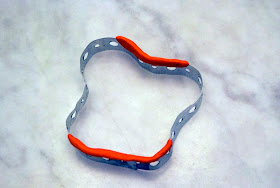We'd never heard of sugru before this year's Maker Faire, where it caught our attention by having hands-on demos and the unabashed enthusiasm of everyone who worked in the Shed. We came home with a pack, not entirely sure what we'd be using it for but thinking it could be a fun material to have around.
Fast forward to the other day in the car, when I idly mentioned that my ideal phone mount would attach to this part of the dash and be angled just so. S's instant response was, "Why don't you just make that with some sugru?" That's how much faith we have in this sci-fi amazing material now.
Sugru is a moldable silicone that cures at room temperature in a matter of hours. It adheres, flexes, and is heat resistant. And it comes in colors, which you can mix. It's like silly putty, but brighter and more durable. It's also like the grip on your favorite kitchen utensil—one you can mold to fit the contours of your own, individual hand.
In just a year, sugru and its users have repaired, tweaked and created a full gallery of applications.
We've used it for typical fixes, like this storage bin whose lid had cracked from being stuffed too full.
Or to cover up a large picture hook which didn't seem decorative enough to hang my favorite broom from.
I'm not much of a baker and have absolutely no talent for decorated sweets; nevertheless, something in me really wanted to make this melted snowman cookie as soon as I saw it. I'm also linking to it because of its story, a likely too-common tale of an idea published for free, only to have others appropriate it as their own.
But back to the cookie: her original directions call for cutting out the melted puddle shape with a knife. I knew I would not have the patience for that and thought it would be faster to make a melted puddle cookie cutter instead.
And yes, you guessed it, sugru was used.
In fact, this is the sum total of what was used: the metal strapping discovered at Halloween (I knew I'd be using it again!), some J-B Weld, and the sugru.
The strapping was bent into shape and epoxied.
Sugru was applied to the top, both to seal the shape and as a bit of a grip.
Had I meant for this to be a lasting cookie cutter, I would have used enough to cover the entire top; but I really wanted to just try this as an experiment first. What is on here is the contents of a single packet. It might take 2-3 packets to cover the entire top edge.
Here are the melted snowmen, made in gingerbread instead of sugar cookie dough (not an improvement, I have been told by the kids) and with the lazy-baker modifications of half a marshmallow for the head and candy-covered sunflower seeds for the nose.
Here are the melted snowmen, made in gingerbread instead of sugar cookie dough (not an improvement, I have been told by the kids) and with the lazy-baker modifications of half a marshmallow for the head and candy-covered sunflower seeds for the nose.
Thank you, Meaghan Mountford, for sharing a fun and adaptable cookie idea. May you regain all the credit you deserve.
















































